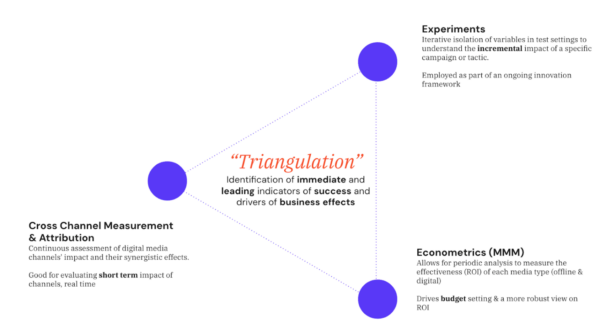Navigating the Attribution Fallacy: Uncovering the True Impact of Your Advertising
September 5, 2024

By Paul R. – Senior Director, Strategy & Planning
Does advertising work? Of course, the answer is yes. But exactly how, and to what extent, are questions that have rarely ever been answered conclusively. And so, the challenge of ‘attribution’ long predates the digital era.
Back in 1963, David Ogilvy coined the famous statement, “Consumers don’t think how they feel. They don’t say what they think, and they don’t do what they say,” reiterating the issues surrounding classical, survey-based methods of advertising effects. The digital era promised a way to navigate this. Every interaction could be tracked, monitored, and reported, seemingly clearing the fog that made it so difficult to answer the simple question: “Is my advertising working?”
Except, it didn’t. Or maybe it did, but beyond the mist was a complex maze of misinformation that has actually been leading marketers astray and undermining the effectiveness of our advertising and communications.
And so, attributing your advertising touchpoints, even just a little more accurately, can be a powerful profit lever for advertisers.
The Attribution Fallacy
We know advertising works in two primary ways: by creating memories that make the brand come “Quick to Mind” and through signposting that makes them “Easy to Find.” The challenge for most methods of attribution is that the majority of advertising effects, especially those that make brands “Quick to Mind,” occur indirectly or significantly later than conventional attribution windows allow. The sustained advertising payback, often making up ~60-80% of advertising effects, typically occurs between 14 weeks and two years after the advertising itself.
In real-time, these effects feel less tangible, leading advertisers to focus on what is tangible—the ~20-40% of effects that occur in the short-mid term.
This focus creates a triumvirate of dilemmas:
1. Creating Bias in Your Media Investment
Because short-term effects feel more tangible, advertisers create a bias in their media investment, favoring channels that appear to deliver ROI immediately and relying on platform attribution to justify the investment. However, platform measures of ROI are often wildly inaccurate and often fail to acknowledge the contribution of other channels or factors to a sale or outcome. This bias and overt focus on short-term ROI at worst only slows potential revenue decay or, at best, harvests demand that is rarely incremental to your sales baseline. This leads us to the second dilemma.
2. The Myth of Demand Creation
This bias towards short-term outcomes, or ROAS (over long-term profit), leads advertisers to believe they can create demand. It allows platforms to focus on the small number of actively in-market buyers, believing they will yield growth. This is problematic for several reasons. First, most in-market buyers have already shortlisted the brands they will buy from before they start showing signals that they are ready to buy, so no amount of clever targeting will convince them to switch. Second, for these audiences to yield growth, they need to buy more often, increase their spend in the category, or choose the advertiser’s brand over more familiar ones. These scenarios are highly unlikely, and advertising tends to be a weak influence in this instance. It is rare that an advertiser can create demand. As Erwin Ephron’s classic line about the “empty cereal box” suggests, most advertising serves to remind consumers about brands they are already familiar with when they need the category.
3. Are Your Sales Truly Incremental?
The final dilemma often results from the first two. The bias in media buying and the myth of creating demand lead to chronic failures in attribution. Advertisers often over rely on platform algorithms that are incredibly good at identifying audiences with a high propensity to convert. This sounds great, but by focusing on these high-propensity audiences, advertisers risk attributing sales to campaigns that would have occurred regardless of advertising exposure. The platform takes credit for a conversion, but the advertiser has just moved a dollar from one revenue column to another, now with an associated media cost that reduces the net profit. Despite growing sophistication in ad tech, there is still limited, if any, correlation between platform-credited conversions and true incremental sales. Remember, the role of advertising is to drive incremental sales to a brand’s baseline. Relying on classic methods of direct attribution leads advertisers astray and potentially costs them where it hurts most—the CFO’s wallet.
The Solution
There is no silver bullet for appropriately assigning credit to all communication touchpoints and identifying what drives incremental sales. However, striving to fully understand how our advertising works through multi-faceted measurement frameworks can be a huge profit lever. It can help minimize wasted ad dollars and maximize the yield from a diverse media mix.
A simple approach can help advertisers develop a focused yet comprehensive method of attributing their investment to outcomes. This approach involves:
Identifying Leading Indicators of Outcomes
Leading indicators could be as simple as leveraging brand health measures that an advertiser wants to influence, as long as they correlate to desired business effects. Another leading indicator is Share of Search (SOS). Not to be confused with anything related to paid search, SOS uses branded search queries relative to competitors as an indicator of brand strength. People tend to search the way they shop, so SOS becomes a real-world, behavioral indicator of brand consideration and tends (although not always) to correlate positively with slow-moving changes in market share.
Leveraging Econometrics, Marketing, and Media Mix Modeling
MMM is becoming increasingly fashionable, and for good reason. With enough historical data, it enables marketers to rationalize long- and short-term investments in financial terms, making a compelling case for multi-channel advertising investment. It’s still not a silver bullet. It can rationalize what has worked in the past, isolate the impact of individual and combinations of channels, and show where opportunities for future investment are likely to yield an outcome. However, it is only as good as the data it leverages. It can’t provide recommendations for untested tactics or solutions and rarely provides guidance on why or how something worked. But it is an excellent tool for guiding macro-level budgeting.
Utilizing Incrementality Testing
Incrementality testing, or controlled experiments, have been leveraged by marketers for decades. It’s a powerful method for validating hypotheses and testing new initiatives through causal impact experiments, match market or geo-lift tests, direct response analysis, or other experiments. This approach complements MMM and, where there is limited historical data, serves as a standalone method for evaluating the incremental impact of advertising.
Yes, Platform Attribution Still Has Its Uses!
While financial ROIs are often wildly inaccurate and of limited use with conventional platform attribution models, MMM and Incrementality Testing can be slow to demonstrate outcomes. This is where platform attribution or direct attribution can be useful, especially for fine-tuning performance and understanding the short-term effect of digital channels in near real-time. Just be wary of the assumed ROI.
The TL;DR:
Attribution is challenging. Classic methods of attribution can lead advertisers astray, resulting in costly, ill-informed decisions. However, striving for greater accuracy in attribution can turn it into a critical profit lever.
As a starting point, consider triangulating these three components:
Build an understanding of how econometrics may support your advertising investment.
Utilize incrementality tests where viable. Even basic controlled experiments can provide valuable data to support better investment decisions.
Continue to use platform attribution for tweaking and optimizing in-channel campaigns in near real-time, but be wary of its ROI limitations.
Additionally, mine for leading indicators of success. In many cases, there is a wealth of readily available data that can support decision-making.
Share of Search is often a great place to start.





























